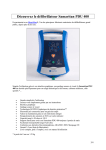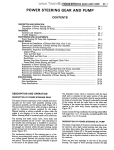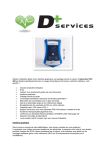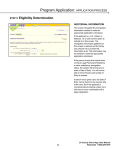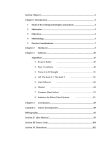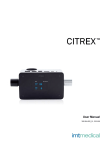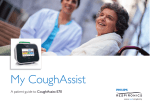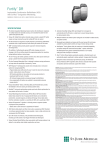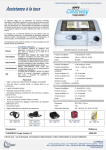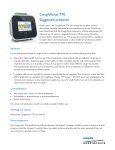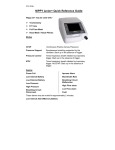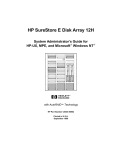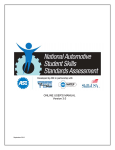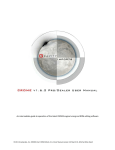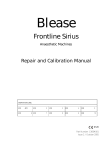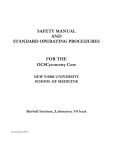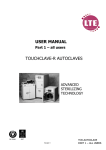Download NIPPY Clearway User Manual Text
Transcript
NIPPY® CLEARWAY COUGH ASSISTOR UK Patent GB2498121 INSTRUCTIONS FOR USE This book must be kept with the machine B & D Electromedical Unit A2 The Bridge Business Centre Timothy’s Bridge Road Stratford–upon-Avon, Warwickshire. CV37 9HW Tel: 01789 293460 Sales 01789 721577 Technical Support Fax: 01789 262470 www.nippyventilator.com Copies of these instructions may be downloaded from www.nippyventilator.com/downloads Doc 2007 Version 4 July 2014 INSTRUCTION MANUAL INDEX Page Operation Description Intended Use Contraindications Features 1-2 3 3 4 Explanation of Controls Explanation of Symbols Used Fascia Buttons Fascia Display Rear Panel Layout Outlets Internal Memory Back up Battery Handheld Ins/Exs Switch 5 6-7 7 8 8 9 9 Getting Started Breathing circuits Switching on/off The Main Screen How to Adjust The Nippy Clearway The Menu Screen How to use the on-screen Menu Structure of the Main Menu How to use the on-screen help Using Help with the Settings Locked 10 10 11 11 12 12 13 14 14 Setting Up Mode Selection Nippy Clearway in Manual Mode Auto Modes Treatment Review Screen Auto Modes manual Override Nippy Clearway in Basic Auto Mode Nippy Clearway in Prog. Timed Auto Mode Nippy Clearway in Prog. Triggered Auto Mode Nippy Clearway in NIV. Mode Advanced Settings - Airway Pressure Vibration Advanced Settings – Post Exsufflation Breaths Insufflation Profile Settings Compliance data Using Supplementary Oxygen Running on Battery Power 15 16 17 18 18-19 20-21 22-23 24 25 25 26 26 27 28 External battery Battery Care Connecting Auxiliary Equipment Pneumatic Diagram Operation Under Extreme Conditions Accessories and Spares Warnings and Cautions 28 29-30 31 31 32 32 33 User Maintenance Servicing Warranty/Transportation Factory Service / Repair Specifications International Standards EMC Information 34 35 35 35 36 36 37-39 Maintenance Locking the Settings 41 Description The Nippy Clearway is a pressure controlled, mechanical insufflator / exsufflator cough assist machine. It assists in the mobilisation and clearance of bronchial secretions by inflating the lungs with a positive airway pressure then providing a rapid change to negative pressure to assist the patient’s cough. In auto modes a graphical representation of the treatment and an audible synchronisation signal is provided to help synchronise the cough effort with the shift to negative pressure. Ambient air is compressed by a turbine and delivered to the patient through a close fitting facemask, mouthpiece or a tracheotomy. Very accurate and consistent pressure control is achieved using the Clearway’s unique bi-directional servo control valve and remote pressure sensing. The pressure displayed on-screen is the actual working pressure at the mask/patient interface. The output pressure and timing can be adjusted by controls on the fascia panel. The Pressure, and all settings are displayed on a colour LCD (Liquid Crystal Display) screen. The settings can be achieved using the buttons around the outside of the display. More advanced features and adjustments can be accessed via the menu. It is designed for non-continuous use. The Nippy Clearway may be used for up to 30 minutes in any 1 hour period. For greater convenience the Nippy Clearway may be powered by an external battery. When using Clearway as a portable device it should be placed in its mobility bag (pt. no. 0960.114) There are 5 modes of operation:Manual Positive and negative pressures are applied using the manual switch on the front of the machine or with a remote handheld switch plugged into the RS232 input. Basic Auto In basic auto mode the Clearway cycles between insufflation and exsufflation followed by a pause, for a maximum of 20 cycles. Timed Programmable Auto The Nippy Clearway can be pre programmed to deliver a timed sequence, which could include one or more insufflations before exsufflation. This sequence can be repeated up to 10 times if desired. Triggered Programmable Auto This is the same as the timed auto mode with patient trigger on insufflations. NIV NIV mode is provided to give the patient up to 15 minutes of respiratory support prior to or post treatment. 1 Alarms The Clearway alarms are all Low Priority. The alarms require operator awareness and alert the operator to a change in the status of the device. The alarm signal consists of an audible alarm and an on screen message to describe the alarm type. There are no user adjustable alarms. Alarm High Pressure Audible Visual High Pressure alarm message on screen Patient Pressure tube disconnected message on screen Priority Low Low External battery Low External battery message on screen Low Low Internal memory Battery Low Internal memory Battery message on screen Machine Fault message on screen, with fault details Low Patient Pressure tube disconnected Fault Low Low Machine Status Max working pressure more than 120% of Insufflation setting Proximal pressure line not connected. Device still functions with possible reduced effectiveness External battery depleted. Machine will function until battery is exhausted. Memory battery voltage low. Machine still functions. User Action Stop using the Clearway Internal fault. Machine malfunction. Stop use. Refer machine to approved repairer Reconnect tube Recharge or replace battery or switch to mains power Run Clearway for 1 hour to recharge battery These alarms may be silenced by pressing the Set button Inspiratory Trigger The Nippy Clearway employs a differential pressure triggering mechanism. By comparing the pressure at the mask end of the breathing circuit with the pressure at the machine end of the circuit, the Clearway is able to detect the start of inspiration. Sensitivity of the trigger is adjustable. The range of adjustment is dependent on the mode selected. In triggered auto mode, the range is 0.5 to 3.5 cm H2O. In NIV mode, the range is 0.5 to 2.5 cm H2O. 2 Intended Use The Nippy Clearway may be used in hospital or homecare environment. The NIPPY Clearway is typically used in patients who are unable to cough and effectively clear secretions due to reduced peak cough expiratory flow as a result of neuromuscular disorders, spinal cord injuries or severe fatigue associated with intrinsic lung disease. It may be used either with a face mask or mouthpiece, or tracheostomy tube. Secretions will usually be cleared to the mouth so yankauer suction may be required. Very young or weak individuals may still need to use naso pharengeal suction. Nippy Clearway must be prescribed by, and used only under the supervision of a qualified physician. Contraindications Pneumothorax or pneumo-mediasinum Facial trauma – interface should be considered Tracheoesophageal fistula Recent or existing barotrauma Bullous emphysema Spinal Instability Acute pulmonary oedema Acute lung injury Caution is advised in patients with cardiovascular instability 3 FEATURES 1. Lightweight, compact fully self-contained unit with lockable settings. 2. Can be used with mouthpiece, full-face mask or tracheotomy. 3. 5 treatment modes. With independent settings 4. Adjustable insufflation pressure profile / rise times. 5. User friendly intuitive software. 6. Easily understood alarm messages displayed onscreen. 7. Employs state of the art microprocessor control. 8. Universal internal mains input, operates anywhere in the world without transformers. 9. Large, colour LCD display, clearly shows all settings. 10. 28 days stored, on-screen compliance data. 11. Comprehensive event log stores all adjustments, settings, and user interventions, for download to PC. 12. Very low maintenance requirements, therefore maintenance costs are extremely low. 13. Twelve months parts and labour warranty. 14. Auto switching to external battery. 15. Automatic service reminder. 4 Explanation of Symbols used on Nippy Clearway and Accessories - Type BF Applied parts to EN 60601-1 - Alternating Current - Direct Current T - Time Delay Fuse SN - Serial Number - Date of Manufacture - Attention. Consult Accompanying Documents - Switch ON /OFF +► - Increase Button ◄- - Decrease Button - Settings Locked / Unlocked - Battery Charged - Battery Discharged - Service Reminder - Dispose of in Line with Local Authority Guidelines - Recycle - Do Not Reuse - Batch Code - Consult Operating Instructions - Green = Manual Control. Flashing = Manual Override available. - 2 post exsufflation breaths selected at end of auto mode - Approximate indication of selected insufflation profile. - Ins and/or Exs oscillation feature selected, showing selected amplitude - Protected against Ingress of solid objects greater than 12.5mm (Finger) - Cooling fan/vent - Standby – Stop/Start M Ins IP20 5 Fascia Buttons 1. Ins - Selects the insufflation positive airway pressure adjustment (scaled in cmH2O). Value is displayed on screen adjacent to the switch. 2. Ti - Selects the insufflation time adjustment (scaled in seconds). Value is displayed on screen adjacent to the switch. 3. Pause - Selects adjustment of the pause time between insufflations (scaled in seconds). Value is displayed on screen adjacent to the switch. 4 .Ins Rpt.- Selects adjustment of the number of insufflations in an auto cycle. Value is displayed on screen adjacent to the switch. 5 .Mode - Displays the mode selection screen. 6. Exs - Selects the exsufflation negative airway pressure adjustment (scaled in cmH2O). Value is displayed on screen adjacent to the switch. 7. Te - Selects the exsufflation time adjustment (scaled in seconds). Value is displayed on screen adjacent to the switch. 8. Cycle Rpt. - 9. Menu/Clear - Selects adjustment of the number of complete cycles in an auto sequence. Value is displayed on screen adjacent to the switch. Displays the menu screen. 10. Help - Displays context sensitive help messages. 11. +► Increments the selected parameter or moves the selection bar up the menu. - 6 12.Set - Selects the current menu function displayed by the selection bar OR double press for hours till next service. 13.◄- - Decrements the selected parameter or moves the selection bar up the menu. 14. Start/Stop - Press to start or stop treatment 15. Start LED Indicates that the Clearway is running. 16. - - 17. Power LED Press to switch on/off. - Indicates that power is connected. 18. Ext.Batt LED - Indicates that the Clearway is running on external battery power. Fascia Display Pressure Display - Indicates insufflation and exsufflation pressure (scaled in cm H2O). Service Reminder - Flashing = major service due External battery - Indicates external battery is connected, Shows red when depleted. Settings locked symbol - This symbol indicates that the settings are locked/unlocked. Trigger indicator - “Flashes” each time the insufflation cycle is initiated by the patient. The number in the box represents the trigger sensitivity setting. Manual Indicator - Solid Green Hand indicates Clearway in manual mode. Flashing hand indicates manual override available. 7 Clearway Fascia 1. Ins/Exs Switch - Manual insufflation/exsufflation switch 2. Mask Pressure - Pressure input. 3. Outlet Patient outlet port. - Rear Panel Layout B & D Electromedical Stratford-on-Avon England. CV37 9HW www.nippyventilator.com SN 3 2 RS 232 100 - 240V 0.7 - 1.3 Amperes 47 - 63Hz N POL E KE YE K USE ONLY 250V FUSES D 1 EUT RI 2 NL 2 IP20 4 Fuse 2 x T1.6A L 250V 0086 Aux Power 24V 4A 1. Aux. Power - 24 Volt connection for external battery. Connect only recommended batteries, part no 0960.111A (1062) 2. Cooling Vent - Cooling air outlet. Do not obstruct. 3. RS232 Port - For connection to accessories. Isolated to 1500 Volts. 4. Power Inlet - Input mains power connector. Double fused. Use B&D supplied power cable 8 Internal Memory Back-up The Clearway contains a rechargeable internal memory back-up battery. This battery is charged when the Clearway is switched on. Due to the intermittent nature of use, this battery may discharge, particularly after long periods of storage. If the battery becomes discharged, a message will be displayed on the screen accompanied by an audible beep. To recharge the battery, plug the Clearway into the mains and switch it on. Leave it switched on for approximately 7 hours. Handheld Ins/Exs Switch The handheld dual function switch allows remote manual operation and start/stop of auto sequences. To use the handheld switch, plug its connector into the RS232 connector on the back of the Clearway. With the Clearway switched on and auto or NIV mode selected, treatment may be started or stopped by pressing the on/off button once. In manual mode or during manual over-ride of auto sequence, the insufflation and exsufflation functions may be operated by either the machine mounted or handheld switch. 9 Getting Started The Breathing circuit Breathing circuit volume = 570 ml including filter. The breathing circuit supplied consists of a 1.5m smoothbore tube with a patient monitoring line/exhale port and a bacterial filter. The bacterial filter is always used at the patient outlet end of the circuit. Connecting the breathing circuit Push the large tube onto the Outlet port. To disconnect, twist the tube before pulling it off. Push the small tube onto the Mask Pressure port. To disconnect, twist the tube before pulling it off. Connect the patient interface to the opposite end of the large tube. To Switch On Place the Nippy Clearway on a clean, smooth, hard surface. (NOT carpet) Connect the power lead to the mains power connector on the rear panel. Plug into the mains power supply. Press the on/off button. To Switch Off Press the onscreen. on/off button. The “Switch Clearway Off” message will appear Press the on/off button again to switch off. Press any other button to cancel switching off the machine. 10 The Main Screen The left-hand side shows the insufflation settings, INS, Ti, PAUSE, INS RPT and also the MODE, adjacent to its setting button. The centre section shows a bargraph display of the airway pressure. The right-hand side shows the exsufflation settings, EXS. Te Also number of times to repeat the cycle, CYCLE RPT and icons for ext battery and locked settings. How to adjust the Nippy Clearway Select the desired parameter with the relevant button. The reading adjacent to the button will be highlighted by a pink flashing box. Alter it with the ◄- or +► buttons. When you have finished, move on to the next adjustment or wait a couple of seconds for the flashing box to disappear. Pressing the SET button will also end the selection and store the setting. E.g. Press INS. INS setting will be surrounded by a pink flashing box. Press +► to increase the pressure setting. 11 Menu Screen The Main Menu gives access to further adjustments and allows you to view information relating to the machine usage. How to use the on-screen menu Press the MENU button. The menu window will be displayed in front of the main screen. Move the selection bar up or down the menu with the ◄- or +► buttons to highlight the desired function and press the SET button to select it. Follow the on-screen instruction at the bottom of the window Press MENU at any time to exit and return to the main screen. Eg. Press MENU. Press ◄- button to move the selection bar over “Settings and Options”. Press SET. Press SET button to select “User Preferences”. Press SET again to move the ◄- and +► symbols either side of “Display Contrast” Press +► to increase contrast Press MENU to exit. 12 Structure of the Main Menu 1. Treatment Review Screen View only 2. Adjust Trigger Levels View / Adjust 3. Settings and Options User Preferences Alarm Volume View / Adjust Display Brightness View / Adjust Display Contrast View / Adjust Keypad Tone Select On/Off Ins vibration level View / Adjust Exs Vibration level View / Adjust Post Exsufflation breaths View / Select Profile Settings View / Adjust Manual View / Select Basic Auto View / Select Programmed Timed Auto View / Select Triggered Timed Auto View / Select NIV View / Select Advanced Setting Mode Select 3. Clear Patient Settings Resets machine to default settings and clears the compliance data, ready for a new patient. 4. Warnings & Cautions Safety information View only 5. Compliance Data Total Hours View only Compliance Hours View only Average Treatment View Only Use + or – button to scroll through the data. Press and hold + and – buttons to reset compliance data 6. Service Menu Service Information Restricted Access 13 How to use the On-screen Help Press the HELP button at any time for a list of help topics. Follow the simple onscreen instructions. Press HELP again to exit. If during setting up, you require a description of a particular parameter, select it then press HELP for a context sensitive help message. Press HELP again to clear. Using Help with settings locked. When the settings have been locked, help is limited to a list of more common problems that may arise during use and advice on how to deal with them. Follow the on-screen instructions 14 Operation All parameters and user inputs are displayed on a large, clear, colour LCD screen. Insufflation and exsufflation pressures are set using the keypad. Settings may be locked to prevent accidental adjustment. The patient must not be left unattended during treatment. Modes of Operation Mode Selection Options The physician may select the modes available to the user. Only the selected modes will be displayed on the mode selection screen. From the main menu select Settings and Options then Mode Select Options. Use the Set button to move up and down the list, and the ◄- and +►buttons to select a mode on or off. Only modes set to On will be available in the mode selection screen. Mode Selection Press the Mode switch to display the list of available operating modes. Use the ◄- and +►buttons to highlight the desired mode. Press the Set button to select. The individual settings for each mode will be retained in memory. This enables different settings to be used in each mode. 15 Manual mode Ins / exs is controlled with the integral Ins/Exs switch or remote hand held switch. The machine outputs the set pressures as the switch is operated. Move the switch to the left for Insufflation, hold to maintain pressure until switch is released. Move the switch to the right for Exsufflation, hold to maintain pressure until switch is released. There are no graphical treatment display screens associated with manual mode Setting up the Clearway in manual mode. Switch on the Clearway and select Manual mode from the Mode select list. (If manual does not appear in the list, this function is not available). Press INS to select the insufflation pressure and use the ◄- and +►buttons to adjust to the required pressure. Press EXS to select the exsufflation pressure and use the ◄- and +►buttons to adjust to the required pressure. Use either the front panel or handheld INS/EXS switch to administer the treatment. 16 Automatic modes A range of automatic treatment modes is available. The Clearway may be programmed to administer the treatment as a sequence of insufflation and exsufflation. As an option, at the end of the sequence, two insufflations may be added to assist re recruitment. This is set through advanced settings, see page 25. The treatment sequence may be reviewed prior to use, in the treatment review screen. Treatment review screen Once an Auto sequence has been determined and set up, it can be viewed in a graphical format by selecting the treatment review option in the main menu. Insufflation (Ti) is shown as a positive waveform, pause (P) as zero and exsufflation (Te) is shown as negative. The Y-axis shows pressure in cm H2O and the X-axis time in seconds. If the entire sequence can be displayed on one screen width, the review screen will look like this:In this example the machine has been programmed to deliver two insufflations followed by one exsufflation. The following insufflations are the optional additional breaths which may be added to re-inflate the lungs If the sequence is repeated or unusually long times are involved it may not be possible to display the whole sequence clearly on one screen width. In this case the review screen will look like this:- In this example the screen shows the first insufflation and exsufflation. To view the rest of the sequence use the ◄- and +► buttons to scroll the display to the left or right. 17 Manual override Occasionally, secretions mobilised by this treatment can cause obstruction of the airways, making the auto sequence inappropriate for the desired outcome. The treatment can be cancelled and forced into manual mode by operation of the manual switch at any time during the auto sequence and for 1 minute after the treatment has finished. Operate once momentarily to cancel the auto sequence and revert to the normal bargraph display and then use as normal for manual operation until secretions are cleared. The Clearway will remain in manual control for as long as the switch is being used. Auto control will be restored when the Start/Stop button is pressed or after 20 seconds of inactivity. Basic Auto Mode In basic auto mode the Clearway cycles between insufflation and exsufflation followed by a pause, for a maximum of 20 cycles. As an option, at the end of the sequence, two insufflations may be added to assist re recruitment. This is set through advanced settings, see page 25. After setting pressures and timing the waveform may be viewed using the Treatment Review screen. Press the Start/Stop button to initiate treatment. The Clearway will start the sequence and the display will change to the active treatment display. This is a graphical representation of the treatment sequence. Insufflation is shown as a positive waveform and exsufflation is shown as negative. The numbers in the top right hand corner of the display indicate the progress. In this example it is showing repetition number 5 of a total of 20. Use the Set button to toggle between the active treatment display and the normal display if desired. To aid synchronisation with the exsufflation, an audible beep will sound just before the start of each exsufflation. Press the Start/Stop button to end treatment. The treatment will continue for a maximum of 20 cycles, then the Clearway will stop. A double beep will sound at the end of the sequence. The patient must not be left unattended during treatment. Manual override may be used at any time during the treatment and is available for 1 minute after the treatment has finished, to provide safer airway clearance. 18 Setting up the Clearway in Basic Auto mode. Switch on the Clearway and select Basic Auto mode from the Mode select list. (If basic auto does not appear in the list, this function is not available to the user. The modes available are selected from the Mode Selection menu see page 15). Press INS to select the insufflation pressure and use the ◄- and +►buttons to adjust to the required pressure. Press Ti to select the insufflation time and use the ◄- and +►buttons to adjust to the required time. Press EXS to select the exsufflation pressure and use the ◄- and +►buttons to adjust to the required pressure. Press Te to select the exsufflation time and use the ◄- and +►buttons to adjust to the required time. Press Pause to select the pause time between cycles and use the ◄- and +►buttons to adjust to the required time. Press menu and select treatment review screen to view the waveform if desired. Press Menu again to escape. Press Start/Stop to begin treatment. Further adjustments may be made to the pressure, time and profile settings during treatment. Press SET to leave the treatment display screen and make the necessary adjustments. 19 Timed Programmable Auto mode The Nippy Clearway can be pre-programmed to deliver a timed sequence, which could include one or more insufflations before exsufflation. This sequence can be repeated up to 10 times if desired. As an option, at the end of the sequence, two insufflations may be added to assist re recruitment. This is set through advanced settings, see page 25. For example, the sequence might be:2 x insufflation followed by exsufflation, repeated twice. In this example a 1 second insufflation @ 10cm is followed by a pause of 2 seconds. This is repeated and followed by a 1 second exsufflation @ -10cm. The whole cycle is then repeated. Press the Start/Stop button to initiate treatment. The Clearway will start the sequence and the display will change to the active treatment display. This is a graphical representation of the treatment sequence. Insufflation is shown as a positive waveform and exsufflation is shown as negative. The numbers in the top right hand corner of the display indicate the progress. In this example it is showing repetition number 1 of a total of 2. Use the Set button to toggle between the active treatment display and the normal display if desired. To aid synchronisation with the exsufflation, an audible beep will sound just before the start of each exsufflation. Press the Start/Stop button to end treatment. A double beep will sound at the end of the sequence. Manual override may be used at any time during the treatment and is available for 1 minute after the treatment has finished, to provide safer airway clearance. 20 Setting up the Clearway in Timed Programmable Auto mode. Switch on the Clearway and select Prog. Timed Auto mode from the Mode select list. (If Prog. Timed Auto does not appear in the list, this function is not available to the user. The modes available are selected from the Mode Selection menu see page 15 Press INS to select the insufflation pressure and use the ◄- and +►buttons to adjust to the required pressure. Press Ti to select the insufflation time and use the ◄- and +►buttons to adjust to the required time. Press Pause to select the pause time between insufflations and use the ◄- and +►buttons to adjust to the required time. Press Ins Rpt. to select the number of insufflations before exsufflation. Use the ◄- and +►buttons to adjust to the required number. Press EXS to select the exsufflation pressure and use the ◄- and +►buttons to adjust to the required pressure. Press Te to select the exsufflation time and use the ◄- and +►buttons to adjust to the required time. Press Cycle Rpt. To select the number of insufflation/exsufflation cycles in the sequence. Use the ◄- and +►buttons to adjust to the required number. Press menu and select treatment review screen to view the waveform if desired. Press Menu again to escape. Press Start/Stop to begin treatment. Further adjustments may be made to the pressure, time and profile settings during treatment. Press SET to leave the treatment display screen and make the necessary adjustments. 21 Triggered Programmable Auto mode The Nippy Clearway can be pre-programmed to deliver a triggered/timed sequence, which could include one or more insufflations before exsufflation or with the exsufflation pressure set to zero, repeated triggered insufflations. This sequence can be repeated up to 10 times if desired. When using the triggered mode, consider lengthening the pause time to allow the patient a comfortable period of time to trigger the breath. If the breath is not triggered before the set pause time is reached, then the device will deliver a timed insufflation. As an option, at the end of the sequence, two insufflations may be added to assist re recruitment. This is set through advanced settings, see page 25. In Triggered mode the sequence will not start until the machine detects the patient’s inspiratory effort, each insufflation can be triggered by the patient. Inspiratory trigger sensitivity may be adjusted by selecting Trigger levels from the main menu. For example, the sequence might be:2 x insufflation followed by exsufflation, repeated twice. Press the Start/Stop button to initiate treatment. The Clearway will wait for the patient to trigger the start of the sequence and the display will change to the active treatment display. This is a graphical representation of the treatment sequence. Insufflation is shown as a positive waveform and exsufflation is shown as negative. The numbers in the top right hand corner of the display indicate the progress. In this example it is showing repetition number 1 of a total of 2. Use the Set button to toggle between the active treatment display and the normal display if desired. To aid synchronisation with the exsufflation, an audible beep will sound just before the start of each exsufflation. Press the Start/Stop button to end treatment. A double beep will sound at the end of the sequence. Manual override may be used at any time during the treatment and is available for 1 minute after the treatment has finished to provide safer airway clearance. 22 Setting up the Clearway in Triggered Programmable Auto mode. Switch on the Clearway and select Prog. Trig. Auto mode from the Mode select list. (If Prog. Trig. Auto does not appear in the list, this function is not available to the user. The modes available are selected from the Mode Selection menu see page 15). Press INS to select the insufflation pressure and use the ◄- and +►buttons to adjust to the required pressure. Press Ti to select the insufflation time and use the ◄- and +►buttons to adjust to the required time. Press Pause to select the pause time between insufflations and use the ◄- and +►buttons to adjust to the required time. Press Ins Rpt. to select the number of insufflations before exsufflation. Use the ◄- and +►buttons to adjust to the required number. Press EXS to select the exsufflation pressure and use the ◄- and +►buttons to adjust to the required pressure. Press Te to select the exsufflation time and use the ◄- and +►buttons to adjust to the required time. Press Cycle Rpt. To select the number of insufflation/exsufflation cycles in the sequence. Use the ◄- and +►buttons to adjust to the required number. Press menu and select treatment review screen to view the waveform if desired. Press Menu again to escape. Insufflation trigger sensitivity may be adjusted by selecting trigger sensitivity from the main menu. Press Start/Stop to begin treatment. Further adjustments may be made to the pressure, time and profile settings during treatment. Press SET to leave the treatment display screen and make the necessary adjustments 23 NIV Mode Up to 15 minutes of non-invasive ventilation may be used to provide respiratory support prior to or post treatment. The Clearway will cycle between IPAP and EPAP at the back up rate unless the patient triggers the inspiratory breath. Press the Mode switch. Select NIV from the mode select screen. Set the desired IPAP, Ti, EPAP, and Rate. Press the Start/Stop switch to begin. Press again to stop. Ins trigger sensitivity may be adjusted by selecting Trigger levels from the main menu. NIV will continue for a maximum of 15 minutes. Do not leave the patient unattended. At the end of treatment a warning will be displayed on screen accompanied by a double beep sound. Ensure an exhalation port is connected in the breathing circuit when using NIV mode Manual override is NOT available in NIV mode. Setting up the Clearway in NIV mode. Switch on the Clearway and select NIV mode from the Mode select list. (If NIV does not appear in the list, this function is not available to the user. The modes available are selected from the Mode Selection menu see page 15 Press INS to select the inspiratory pressure (IPAP) and use the ◄- and +►buttons to adjust to the required pressure. Press Ti to select the inspiratory time (Ti) and use the ◄- and +►buttons to adjust to the required time. Press INS Rpt. to select the back up rate and use the ◄- and +►buttons to adjust to the required rate. Press Exs to select the expiratory pressure (EPAP) and use the ◄- and +►buttons to adjust to the required pressure. Press menu and select treatment review screen to view the waveform if desired. Press Menu again to escape. Press Start/Stop to begin treatment. Further adjustments may be made to the pressure, time and back up rate settings during treatment. 24 Advanced Settings Oscillation of airway pressure In some cases it may be benificial in the mobilisation of secretions to “vibrate” the airway pressure. The Nippy Clearway can be set to vibrate the insufflation or exsufflation pressure at 4Hz ( cycles per second). The level of vibration can be preset to 25%, 50%, 75% or 100% of the working pressure. The Airway vibration function may be accessed via the Advanced Settings screen. Press Menu and select Settings and Options and then Advanced Settings from the list. Use the Set button to move between Ins and Exs vibration and post breaths settings. Use the ◄- and +►buttons to select the desired vibration level and then Set to accept. Default setting is for vibration settings to be off. Post exsufflation breaths The post exsufflation breaths function may be accessed via the Advanced Settings screen. Press Menu and select Settings and Options and then Advanced Settings from the list. Use the Set button to move between Ins and Exs vibration and post breaths settings. Use the ◄- and +►buttons to toggle between on and off. Press Set to accept. Default setting is for post exsufflation breaths to be off. 25 Profile Settings The insufflation pressure profile or rise time may be adjusted. The adjustment may be accessed via the Settings and Options screen. Press Menu and select Settings and Options and then Profile Settings from the list. Use the ◄- and +►buttons to select the desired setting. Press menu to exit the profile screen. The profile symbol to the left of the main pressure display will give an approximate indication of the profile selected. The rise time may be set to 10 – 80% of Ti up to a maximum of Ti = 1 second. So if Ti is less than 1 second, rise time is a percentage of Ti. Therefore 50 = 50% Ti If Ti is greater than 1 second, rise time is a percentage of 1 second. Therefore 50 = 500mS Compliance data Up to 28 days compliance data may be viewed on the compliance data screen. Press Menu and select Compliance Data from the list. The compliance data is displayed in a chronological list format. Use the ◄- and +►buttons to scroll up and down the list. 26 Using Supplementary Oxygen with the Nippy Clearway If required, supplementary oxygen may be entrained into the breathing circuit up to a maximum of 15 L/minute. When adding oxygen, fit an entrainment port at the mask / tracheotomy end of the circuit. Oxygen Port Proximal pressure Line Clearway Outlet Port Mask/Trachy Switch on the Clearway before the oxygen. When treatment is complete, switch off and disconnect the oxygen supply, Switch off the Clearway and disconnect the breathing circuit. Store the breathing circuit in a clean bag or other suitable container. DO NOT leave the oxygen connected when not in use. This can cause a build-up of oxygen in, or around the machine DO NOT block the end of the breathing circuit with oxygen connected. DO NOT expose oxygen to naked flames. DO NOT smoke in the vicinity DO NOT use a gas cooker in the vicinity DO NOT use a gas, oil or solid fuel heater in the vicinity Precaution: always follow user instructions when entraining Oxygen. 27 Running the Nippy Clearway on Battery Power Nippy Clearway may be powered from the mains or an external battery. The machine will select its power source, according to the power available, in the following sequence:1. – Mains Electricity 2. - External Battery (if connected) In order to save battery power, the machine will always run on mains electricity if it is present. If the mains fails or is not connected, the machine will select external battery as the next choice. If there is no external battery the machine will shut down. Battery Run Times Battery run times are dependent on the machine settings and the amount of leak. High pressures and /or high breath rates use power and therefore shorten run times. Large leaks use power and shorten run times. Average run time is expected to be approx. 1 hour. External Batteries The external battery pack is supplied specifically to power the Nippy Clearway. External battery part number 0960.111A (1062) External battery charger part number 0960.112 (0999) These batteries should never be used to run any other type of equipment. DO NOT attempt to connect any battery other than those supplied by the manufacturer. Use of any other type of battery could lead to personal injury and damage to the machine. NL2 OLE KEY E D T EU RI K Polarising recesses 2P It has two polarising keys of different sizes which must be aligned with the corresponding recesses in the aux power socket. N The external battery connector is of a touch proof, self-locking design. To connect the external battery grip the battery connector body (coloured blue) and insert into the aux power socket. Twist clockwise to lock in place. To disconnect, grip the battery connector locking sleeve (coloured grey), turn anticlockwise and withdraw the connector. 28 Instructions For Use Connect the battery to the Nippy Clearway Aux Power input. The Power light will illuminate. Switch on the Nippy Clearway. The Ext Batt light will flash and a “Running on battery power” message will be displayed on the Nippy Clearway screen. Press the Set button to hide the message. To disconnect a battery: Always switch off the machine first. To Charge a Battery Place the charger on a smooth flat surface. Connect the charger to the battery charge socket before switching on the mains power. Connect the mains plug to the AC supply and switch on. Leave on charge until the charged / ready indicator lights. Batteries may produce explosive gases during charging. Always charge away from sparks or sources of ignition. Do not smoke near a battery whilst charging. Disconnect the mains power before disconnecting the battery from the charger. Batteries may be left connected to the charger until required for use. Safety Warning! High voltages exist inside the charger. Do not remove the cover. Return to B & D Electromedical if a fault occurs. Do Not expose to water or dust. Do not cover the charger whilst in use Ensure that the mains lead is not damaged. Do not attempt to charge any other type of battery with it. Battery pack cleaning To clean, wipe the exterior of the case with a soft cloth moistened with water. Battery Care DO NOT use any other type of battery charger. This could lead to damage to the battery and personal injury. The battery should be recharged as soon as possible after use. This type of battery does not suffer from the memory effect that is widely talked about and does not need to be fully discharged before charging. Batteries like to be used. A new battery may require several charge/discharge cycles before it reaches its maximum performance. The same applies to a battery that is only used occasionally with long periods in storage. 29 Battery Life The end of life is defined by the maximum running time falling to 75% of that of a new battery. For a battery that is used occasionally service life is 2 years. Replace the battery when running times drop below those indicated or after 2 years. Battery Storage This type of battery is best stored partly charged. A battery that is not in use will slowly discharge. This rate of discharge increases with temperature. Ideally the storage temperature should be above -20oC and below 20oC. It must be below 40oC. After storage in a cold environment allow 24 hours for the battery to reach room temperature before use. Fully charge the battery every 2 months. Battery Test Test the battery monthly or if the running time seems low, a fault is suspected, or to confirm that the battery is good. Ensure the battery is fully charged. Run the machine from the battery until the low battery alarm operates and record the running time. If the battery run time is less than 30 minutes replace it. If the battery is good, fully recharge it immediately after testing. Hints and Tips for Reliable Operation Always make sure that the battery is fully charged before use. Do not switch off charger until battery is fully charged. Avoid the temptation to give the battery “a quick boost”. This is of no benefit. If you are in doubt the state of charge, charge for at least 24 hours. If running time suddenly seems considerably shorter than normal, make sure that the battery is fully charged. Do not charge your battery near sources of ignition. Check the running time of your system regularly. If you have more than one battery, use them in rotation. Do not use if any of the cables or components show any sign of damage. Most reported problems arise from incorrect battery charging. Disposal of depleted batteries Depleted batteries may be disposed of in line with local authority regulations. 30 Connecting auxiliary monitoring equipment For monitoring or downloading data the Nippy Clearway may be connected to a PC or Laptop computer. The Nippy Clearway isolated RS232 port is safe for use with any domestic PC or laptop computer. However, when assembling a system, the completed system should comply with EN60601-1 (medical systems). For example, most computers do not comply with this standard, so it should be sited at a distance, which makes it impossible to touch the computer and the patient at the same time. Clearway System Pneumatic Diagram 1. Fresh air inlet 2. Vacuum connection 3. Pressure Connection 4. Outlet connector 5. Mask Pressure port 2 6. Pressure transducer 1 3 Blower 7. Pressure transducer 2 8. Exhaust Port 9. Breathing Circuit 10. Pressure / Exhalation Port 11. Patient Connection Port 9 Valve 4 8 11 10 7 5 6 31 Operation Under Extreme Conditions Ambient Temperature in the range of +5 to +50 oC Between 5 and 40 degrees functioning of the machine should not be affected. Extremes of temperature (below 5 oC, above 40 oC) may affect the colour of the LCD display. This will return to normal with the temperature. Operation above 40 degrees is not recommended. The machine may overheat at elevated temperatures. A visual alarm will be activated in the event of over temperature (Internal ambient >50). Air conditioning should be employed to keep the room temperature below 40 degrees. Ambient Relative Humidity in the range of 10 to 100% RH The machine is expected to function correctly at extremes of humidity. High humidity levels may affect the colour of the LCD display. This will return to normal with the humidity. Atmospheric Pressure in the range of 600mBar to 1100mBar The machine is expected to function correctly between 600 and 1100 mBar. Supply Voltage Range from –20% to +10% of specified value The Nippy Clearway will operate normally. Failure of Electrical Power Supply The machine may be operated normally using an external battery. During total power failure, there will be no output from the machine. The patient will be able to breathe spontaneously through the machine and out through the exhale port. However, some re-breathing of exhaled gas is inevitable. During power/machine failure disconnect the patient from the breathing circuit as soon as possible. The inspiratory / expiratory resistance of the Nippy Clearway and breathing system (Nippy Clearway and circuit) is less than 6cm H2O @ 60 l/min. This value must not be exceeded when adding attachments or fittings to the breathing circuit. Accessories and Spares A range of mouth pieces and facemasks is available in various sizes. Please contact us for details A range of breathing circuits is available for use with mouth piece, facemask or tracheotomy. Input Air Filter Element pt.no. 0960.116 (pack of 5) Inline Bacterial Filter pt.no. 0960.107 - 99.999% filtration – Resistance, 0.75mB @ 50 l/min – deadspace 55ml – 22mm tapered fittings. These components listed above are for single patient use. External battery, part number 0960.111A (1062) Hand held switch. Part number 0960.109 Mobility Bag. Part number 0960.114 32 WARNINGS No modification of this equipment is allowed. Do not attempt to pass oxygen into the panel mounted air inlet, or use with flammable anaesthetic agents e.g. Ether etc. CAUTIONS The Nippy Clearway should only be used in accordance with the instructions of the supervising physician. Personnel using and operating the Nippy Clearway must become familiar with this instruction manual before using the unit. Ensure patient safety through the presence of a trained attendant and an alternative means of treatment. The Nippy Clearway should not be placed close to high frequency surgical diathermy, defibrillator or short wave therapy equipment as it may adversely affect the operation. The functioning of the machine can be adversely affected by electromagnetic interference exceeding the level of 3V/m in the test conditions of EN60601-1-2. e.g. mobile telephone operation may adversely affect the operation of the machine. If the Nippy Clearway is moved from cold surroundings into a well-heated room, condensation may form. Do not operate the unit for at least 2 hours to allow any condensation to evaporate. Do not operate the machine in direct sunlight. Avoid places where there is excessive humidity or dust, which may cause damage to internal parts. Keep the Nippy Clearway away from extreme direct heat, such as fires, heating radiators etc., and always allow a 100mm (4.0in) air space around the unit when in use. If liquids are allowed to enter the unit, serious damage could occur. If you spill any liquid into the Nippy Clearway, consult qualified service personnel. Do not place any form of cover over the machine, especially near the air intake. DO NOT use anti static or electrically conductive tubing. Adding extra components / sub-assemblies to the breathing circuit may cause the pressure, during expiration, at the patient connection port of the breathing circuit to increase. If intending to transport the device or use in multiple locations the device should be placed in the mobility bag (0960.114) to provide protection against the elements. 33 USER MAINTENANCE YOU MUST DISCONNECT THE NIPPY FROM THE MAINS SUPPLY BEFORE ANY MAINTENANCE IS CARRIED OUT User maintenance is limited to cleaning and visual inspection of the machine, the input air filter and the breathing circuit. The machine and the detachable mains cord set should be inspected for signs of external damage weekly. If any damage is evident (particularly to the mains cord set) refer repair to appropriately qualified technical personnel. DO NOT immerse the machine in or spray with water DO NOT use solvent cleaning agents or detergents DO NOT use abrasive cleaning agents Mains Power Lead Before using the Clearway, inspect the mains lead for damage. Do not use if there is any damage to the plug, socket or the insulation. Exterior of Case To clean, wipe the exterior of the case with a soft cloth moistened with water. Input Air Filter The input air filter should be inspected weekly. Replace when visibly soiled. It is located on the rear of the machine. To remove the filter, grip the filter housing with the thumb and forefinger, across the top corners and pull the filter cover away from the machine. Remove and inspect the element. the filter element requires GRIP GRIP Ifreplacement, use only recommended spares (see spares list). The use of any other filtering material may impair the performance of the machine. Never attempt to clean the filter element with solvent cleaning agents. Do not operate the machine unless the input air filter is in place. User Maintenance Schedule Before Use Daily Weekly Batteries Test Breathing Circuit Inlet Filter Power Cord Monthly Inspect Replace Inspect/Replace Inspect Breathing Circuit Cleaning The breathing circuit is considered disposable and for single patient use. 34 Servicing/Repair Only suitably qualified technically competent personnel should attempt servicing of this machine. The expected service life of the clearway and its remote switch is 5 years. To maintain its performance, the machine will require periodic servicing at the following intervals: Annual, electrical safety test. Interim service every 3 years Details of service requirements are contained in the technical manual. In the event of damage occurring to the machine, it should be inspected by technically competent personnel prior to use. Technical Information A technical manual incorporating circuit diagrams and descriptions will be made available, on request; to enable appropriately qualified technical personnel to repair the parts of the equipment designed to be repairable. Warranty The Nippy Clearway is covered by a full 2 years parts and labour warranty, provided that the unit is properly operated under conditions of normal use. This warranty does not apply to any unit that has been subjected to misuse or accidental damage, or repaired or modified by unauthorised personnel. Transportation When shipping, damage as a result of inadequate packing is the customer's responsibility. Use the original packing materials whenever possible. In the event of a breakdown or damage to the machine, refer servicing or repair to qualified and competent technical personnel. Factory Service / Repair Damage to either the machine or its mains lead must be inspected by competent technical personnel before use. B & D Electromedical products returned for factory service or repair must have a Return Material Authorisation (RMA) number assigned. This is essential for efficient processing of repairs. You can obtain your RMA number by calling 01789 293460 with the following information: 1. Unit Model 2. Serial number 3. Your name, address and telephone number 4. Complete description of the malfunction or service required When the RMA number has been issued, we will arrange for the unit to be collected. Place the RMA number on the outside of the carton. The unit must be properly packaged before shipment. Preferably, in the original packaging. Please ensure unit is accompanied by a declaration of decontamination. B & D Electromedical are not responsible for inbound transit damage. When enquiring about a returned item, you must quote the RMA number. Disposal at end of Life The Nippy Clearway should be disposed of in line with local authority guidelines / regulations. Spent batteries should be disposed of in line with local authority guidelines / regulations. 35 Specification Modes Manual – integral or hand held remote switch Basic Auto Programmable Timed Auto Programmable Triggered Auto NIV Basic Auto mode Insufflation pressure 60cmH2O (0 – 6 kPa) Exsufflation pressure -60cmH2O (0 - -6 kPa) Run Time 20 cycles Programmable Auto modes Insufflation pressure 60cmH2O (0 – 6 kPa) Exsufflation pressure -60cmH2O (0 - -6 kPa) Number of Insufflations (prior to exsufflation) 1 - 10 Insufflation time (Ti) 0.5 - 5 sec Exsufflation time (Te) 0.5 – 5 sec Pause time 0 - 5 sec (at zero pressure) Number of cycles 1 –10 (total of insufflations + exsufflation = 1 cycle) Trigger 1 – 5 cmH2O NIV mode (pressure controlled) IPAP 3 - 40cmH2O (0.3 – 4 kPa) EPAP 3 - 10cmH2O (0.3 - 1 kPa) Inspiratory Time (Ti) 0.5 - 3 sec Back up Rate 6 – 60 BPM Run Time 15 minutes Trigger 0.5 – 2.5 cmH2O Size 297 x 223 x 132mm Weight 3kg Supply Voltage 100 - 240 V ac Supply Frequency 47 - 63 Hz Type of protection against electric shock Class ll equipment Degree of protection against electric shock Type BF to EN 60601-1 Fuse 2 x T1.6A L 250V Mode of operation Intermittent. 30 minutes use in 1 hour External battery (Li-Ion) - 25.5Vdc 155Whr IP Rating - 20 Protection against flammable anaesthetic mixtures - Not suitable for use in the presence of a FLAMMABLE ANAESTHETIC MIXTURE WITH AIR OR WITH OXYGEN OR NITROUS OXIDE International Standards EN 60601-1:2006, EN 60601-1-8, EN 60601-1-11, EN 60601-1-6 Safety of Electromedical Instruments, General Requirements Electromagnetic Compatibility (In accordance with the EMC Directive 2004/108/EC) B & D Electromedical declares that the Nippy Clearway complies with the following EMC standards. EN60601-1-2: 2007 Test results available for review from B & D Electromedical 0086 36 EMC Information Guidance and Manufacturer’s Declaration – Electromagnetic Emissions: The Nippy Clearway is intended for use in the electromagnetic environment specified below. The user of the Nippy Clearway should make sure it is used in such an environment. Emissions Test Standard Electromagnetic Environment- Guidance RF emissions (radiated) EN55011 The Nippy Clearway uses RF energy only for its internal function. Therefore, its RF emissions are CISPR 11 very low and are not likely to cause any interference in nearby electronic equipment. RF emissions (conducted) EN55011 The Nippy Clearway is suitable for use in all establishments, including domestic establishments and CISPR 11 those directly connected to the public low-voltage power supply network. Harmonic emissions EN61000-3-2 IEC 61000-3-2 Voltage fluctuations/Flicker EN61000-3-2 emissions IEC 61000-3-3 Electromagnetic Immunity: This Nippy Clearway is intended for use in the electromagnetic environment specified below. The user of the Nippy Clearway should make sure it is used in such an environment. Immunity Test IEC 60601 Test Compliance Level Electromagnetic EnvironmentLevel Guidance Electrostatic ±6 kV contact ±6 kV contact Floors should be wood, concrete or ceramic tile. If floors are covered Discharge (ESD) ±8 kV air ±8 kV air with synthetic material, the relative humidity should be at least 30%. IEC 61000-4-2 Electrical Fast ±2 kV for power supply lines ±2 kV for supply mains Mains power quality should be that of a typical home or hospital Transient/Burst ±1 kV for input-output lines ±1 kV for input/output lines environment. IEC 61000-4-4 Surge ±1 kV differential mode ±1 kV differential mode Mains power quality should be that of a typical home or hospital IEC 61000-4-5 ±2 kV common mode ±2 kV for common mode environment. Voltage dips, short >95% dip in Voltage for 0.5 >95% dip in Voltage for 0.5 Mains power quality should be that of a typical home or hospital interruptions and periods periods environment. If the user of the Nippy Clearway requires continued voltage variations @ 230Vac and 100Vac @ 230Vac and 100Vac operation during power mains interruptions, it is recommended that on power supply 60% dip in Voltage for 5 periods 60% dip in Voltage for 5 periods the Nippy Clearway be powered from an uninterruptible power supply input lines @ 230Vac and 100Vac @ 230Vac and 100Vac or a battery. IEC 61000-4-11 30% dip in Voltage for 25 30% dip in Voltage for 25 periods periods @ 230Vac and 100Vac @ 230Vac and 100Vac Power frequency (50/60 Hz) magnetic field IEC 61000-4-8 3 A/m 3 A/m Power frequency magnetic fields should be at levels characteristic of a typical location in a typical hospital or home environment. 37 Electromagnetic Immunity: This Nippy Clearway is intended for use in the electromagnetic environment specified below. The user of this Nippy Clearway should make sure it is used in such an environment. Immunity Test IEC 60601 TestLevel Compliance Level Electromagnetic Environment- Guidance Recommended separation distance: Conducted RF 3 Vrms 3 Vrms d = 1.2√P @150 kHz to 80 MHz IEC 61000-4-6 150 kHz to 80 MHz d = 1.2√P @ 80 MHz to 800 MHz d = 2.3√P @ 800 MHz to 2.5 GHz Portable and mobile RF communications equipment should be used no closer to any part of the Nippy Clearway, including cables, than the recommended separation distance calculated from the equation applicable to the frequency of the transmitter.Where P is the maximum output power rating of the transmitter in watts (W) d is the recommended separation distance in meters (m). Field strengths from fixed RF transmitters, as determined by an electromagnetic site survey, should be less than the compliance level in each frequency range NOTE 1: At 80 MHz and 800 MHz, the higher frequency range applies. NOTE 2: These guidelines may not apply in all situations. Electromagnetic propagation is affected by the proximity of structures, objects, and people. a: Field strengths from transmitters, such as base stations for radio (mobile/cordless) telephones, amateur radio, AM and FM radio broadcast and TV broadcast cannot be predicted theoretically with accuracy. To assess the electromagnetic environment due to fixed RF transmitters, an electromagnetic site survey should be considered. If the measured field strength in the location in which the Nippy Clearway is used exceeds the applicable RF compliance level above, the Nippy Clearway should be observed to verify normal operation. If abnormal performance is observed, additional measures may be necessary, such as relocating the Nippy Clearway. Radiated RF IEC 61000-4-3 3 V/m 80 MHz to 2.5 GHz 3 V/m Recommended Separation Distances between Portable and Mobile RF Communications Equipment and This Nippy Clearway: The Nippy Clearway is intended for use in an electromagnetic environment in which radiated RF disturbances are controlled. The user of this Nippy Clearway can help prevent electromagnetic interference by maintaining a minimum distance between portable and mobile RF communications equipment (transmitters) and this Nippy Clearway as recommended below, according to the maximum output power of the communications equipment. Separation Distance According to Frequency of Transmitter Rated Maximum Power Output of Transmitter (W) (m) 150 kHz to 80 MHz 80 MHz to 800 MHz 800 MHz to 2.5 GHz d = 1.2 √P d = 1.2 √P d = 2.3 √P 0.01 0.12 0.12 0.23 0.1 0.38 0.38 0.73 1 1.2 1.2 2.3 10 3.8 3.8 7.3 100 12 12 23 38 For transmitters rated at a maximum output power not listed above, the recommended separation distance d in meters (m) can be estimated using the equation applicable to the frequency of the transmitter, where P is the maximum output power rating of the transmitter in watts (W). Note 1: At 80 MHz and 800 MHz, the separation distance for the higher frequency range applies. Note 2: These guidelines may not apply in all situations. Electromagnetic propagation is affected by absorption and reflection from structures, objects, and people. Typical Power Output of Some Common Transmitters This list is provided for general guidance. It is not exhaustive or specific. It not intended to replace the findings of an electromagnetic survey. Suggested Minimum Separation Distance Power Notes This is a very approximate guide. If abnormal operation is observed, disregard this figure and take corrective action. 100 kW Typical transmission power of FM radio station with 50 km range Maximum allowed output RF power from a amateur radio transceiver without 1 kW = 1000 W special permissions 100 W Typical maximum output RF power from a amateur radio transceiver Typical maximum output RF power from a hand held amateur radio 5W transceiver Typical maximum output power for a Citizens' band radio station, (27 MHz) in 4W many countries Maximum output from a UMTS/3G mobile phone (Power class 1 mobiles) 2W Maximum output from a GSM850/900 mobile phone Typical cellular phone transmission power 500 mW Maximum output from a UMTS/3G mobile phone (Power class 2 mobiles) 400 mW Access point for Wireless networking 250 mW Maximum output from a UMTS/3G mobile phone (Power class 3 mobiles) 32 mW Typical WiFi transmission power in laptops. 2.5 mW Bluetooth Class 2 radio, 10 m range 1.0 mW = Bluetooth standard (Class 3) radio, 1 m range 1000 µW Typical maximum received signal power (−10 to −30 dBm) of wireless 100 µW network 39 727m 73m 23m 5m 4.6m 3.25m 1.6m 1m 1.15m 40cm 11.5cm 7.2cm 2.3cm THIS PAGE MAY BE REMOVED BEFORE THE INSTRUCTION MANUAL IS PASSED TO THE USER Locking the settings The settings can be locked to prevent unauthorised adjustment. To lock press ◄- and +► buttons simultaneously and hold for 2 seconds. To unlock press ◄- and +► buttons simultaneously and hold for 2 seconds. This prevents adjustment but allows the user to switch the machine on and off.













































